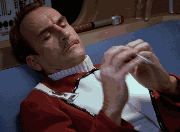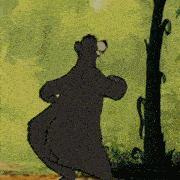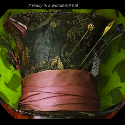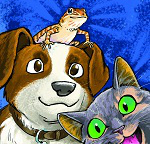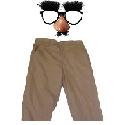|
What's the portability on something like an Orion SpaceProbe 130ST EQ-2? Looking for something that will be relatively useful from my apartment in a small European city (light pollution level is Bortle 5 on my balcony), but also easy enough for me to schlep somewhere in a large rucksack and in public transport (I don't own a car). Looking at that ~300 Euro price point too. If portability weren't a factor at all, or if I owned a car, I'd be looking at an XT8, but then I can throw portability out the window. Edit: this thread seems to be pretty astrophotography-focused, so just throwing out there that I'm only interested in visual astronomy with this thing. Drone fucked around with this message at 19:01 on Jul 30, 2018 |
|
|
|
|

|
| # ? May 29, 2024 07:00 |
|
It’s bested by the Heritage 130P, which has the same aperture with a collapsible tube. The mount is smaller, lighter, more stable, and easier to use, but will need to be placed on something to be at a comfortable height.
|
|
|
Platystemon posted:placed on something to be at a comfortable height. That's the rub for me on the Heritage 130P. If I didn't care about being able to easily take the thing out to a field somewhere without having to lug along a collapsible table, it'd be another matter. Drone fucked around with this message at 07:44 on Aug 1, 2018 |
|
|
|
|
EQ2 is woefully undersized for basically anything. The Heritage 130p would be the better choice, imo, even if you have to knee down to observe. Also don't mind me shitposting my astrophotography here, visual observation is welcome as well!
|
|
|
|
Equatorial mounts are heavy and awkward. Alt–az on a photo tripod is better if you need something that can stand alone. I would prefer even a collapsing table or stool.
|
|
|
|
Hi astrogoons, I'd like to get my dad a telescope, mainly for him to use in the garden (probably wouldn't be taken many places I mean). Would be nice if it was relatively easy to setup, don't want it to be too heavy/bulky. He's had a couple in the past but nothing particularly serious. Is the Heritage 130p a good option for something like that? I was also looking at the Explorer 150P EQ3-2, which is pretty big but the fact it has a stand etc seems useful. If there's a more suitable thread I'll post there, this just came up when I searched for telescope
|
|
|
|
I bought a Heritage 130p last month and I love the thing. How are the skies where your dad lives, and does he have a sturdy table to set this thing up on in his garden? The main draw of the 130p is its portability and quality for the price. If he's not going to be using the telescope anywhere besides his garden, and if he's capable of moving something a bit larger from indoors into the garden and back again, then maybe look into a full-sized 6" or 8" Dob instead (the Orion XT6 and XT8 pop out in my mind).
|
|
|
|
|
Skies are okay, he's in the south of England though so a few towns within 10 miles. There's a couple of stone tables in the garden I could help move into position. My thought was since it's quite good and portable for the price, I could start him with this one and if he gets a lot out of it he can move up from there. But I guess you can see way more with a 6" dobsonian, so maybe a tougher decision than I thought.
|
|
|
|
Hey everyone, go take a look at the comet 21P/Giacobini–Zinner if you have the chance. I should have posted this last week. It passed perihelion a couple of days ago. Right now it’s in Auriga and it’s headed for Gemini, so it rises late. Finder chart here. Magnitude is circa 7.5. In binoculars, it is comparable to one of the better galaxies.  Photo by Michael Jäger e: Let me be clear that I am not Michael Jäger. Platystemon fucked around with this message at 00:34 on Sep 13, 2018 |
|
|
|
Nice photo. I'd try to image it but we've had nothing but clouds and rain here in Maryland for what seems like weeks 
|
|
|
hannibal posted:Nice photo. I'd try to image it but we've had nothing but clouds and rain here in Maryland for what seems like weeks Texas feels the same. Very nice photo though.
|
|
|
|
|
Earlier this week, I saw something in the sky I couldn’t explain. I was looking through the telescope at an area of Cassiopeia when I saw a point of light blinking on and off every few seconds. It was maybe twelfth magnitude. As I watched it, it moved slowly, taking several minutes to traverse half a degree. Moving at that speed, it couldn’t have been a plane, a distant astronomical object, or anything in low orbit. I think it was a satellite in Molniya orbit. I didn’t check against specific satellites in the database, but the location and speed on the celestial sphere are about right.
|
|
|
|
It was the Bart Simpson comet.
|
|
|
|
I found this thing I used to have as a kid, anyone recognize it? As scopes go I assume it has been surpassed, must be from the 80s or early 90s. But I was thinking I'd fix it up none the less. It says: Astronomical Telescope D = 50 mm, F = 300mm Japan 
|
|
|
|
Something unfortunate is that it takes 0.965-inch eyepieces. Everyone went inch-and-a-quarter since.
|
|
|
|
It's absurd what can be seen from down here on the ground without using an observatory. It's hard for me to comprehend.
|
|
|
|
Dick Trauma posted:It's absurd what can be seen from down here on the ground without using an observatory. It's hard for me to comprehend. If you know where to look and have good enough skies, the naked eye can see a *lot* that the average person wouldn't otherwise notice or recognize- in addition to a few bright galaxies, there's quite a few visible star clusters (both open and globular), nebulae, Uranus, and there are even a couple asteroids bright enough to see (Vesta most of the time, Ceres occasionally.)
|
|
|
|
The Orion Nebula (M42) is the only nebula I’ve ever been able to see with the naked eye, unless you count M31 as the “Great Nebula in Andromeda” or count the Magellanic Clouds. Here is a claim of seeing the Ghost of Jupiter and a rundown of some of the other possibilities. Star clusters are everywhere. Platystemon fucked around with this message at 03:05 on Oct 28, 2018 |
|
|
|
I saw Callisto (I'm pretty sure) with the naked eye once, when I was a kid and still had super sharp vision. Very faint point of light just barely separated from Jupiter, but non-twinkling.
|
|
|
|
I got a tracking scope (Celestron Starsense) to go with my AVX mount a couple weeks ago and we finally have clear enough weather to play around with it. I broke out the 8" reflector and fixed it up - a couple of the screws were stripped and I couldn't collimate it before - and tried pointing it at Andromeda last night: This is an almost entirely unprocessed stack of 90x30sec at ISO800, I just adjusted the light/dark values a bit. I would have liked longer exposures, but I'm right on the edge of the city so there's a ton of light pollution... if I set the exposures any longer or ISO any higher it just blew the whole drat thing out. A couple more hours of exposure time would have been great, too, but it was 15F out, and that's just not pleasant. I'm not sure if there's much value to processing it further, but I'm really happy with how this thing is tracking and am hopefully gonna get out of town soon to try some half-decent shooting. Also, it looks like Imgur is adding its own jpg compression to the bright areas... I should really get a Flickr.
|
|
|
|
Ok, it turns out that Imgur wasn't adding compression, the weird artifacts I was seeing in that last shot are from DSS using its own white balancing and I didn't know it did that at all. I got back out Saturday and got around two hours of exposures, got the right settings in DSS this time, and processed in PixInsight. I'm really happy with how it turned out, given that it's entirely in the visible light spectrum: M31, Canon 80D (unmodified) 230@30sec ISO800 I'm really having fun figuring out the quirks of this whole process. Tracking was pretty good this time, especially given that I was shooting almost directly overhead for a lot of it. I've never actually been shooting while the target passed the meridian and wasn't sure what the telescope would do - whether it would flip all the way back around and keep tracking or not. Turns out, it just locked straight up and made me re-focus on the target with the handset. Just a little thing for me to keep in mind, I guess. I think the next thing I need to do is figure out a camera. I've got an old Canon T3i that I could try to remove the IR filter from... has anyone had good results with doing that themselves? I've done a lot of laptop repairs in the past and am not too worried about taking apart small electronics, but I've never done any work on a DSLR before and wouldn't want to break the thing. Or, would I be better off spending the money and going with a dedicated astrophotography camera?
|
|
|
|
Golden-i posted:Ok, it turns out that Imgur wasn't adding compression, the weird artifacts I was seeing in that last shot are from DSS using its own white balancing and I didn't know it did that at all. I got back out Saturday and got around two hours of exposures, got the right settings in DSS this time, and processed in PixInsight. I'm really happy with how it turned out, given that it's entirely in the visible light spectrum: Those are some amazing results! re: camera advice - if you remove the IR filter and don't replace it with an equivalent "non-filter", the camera won't focus properly anymore (the diffraction of the IR filter is taken into account in the camera's focal plane). It's not impossible to modify a DSLR, but you need some custom replacement parts. It's not a huge loss of quality, but it's still fuzzier than an unmodified camera, from what I've heard.
|
|
|
|
Infinite Karma posted:Those are some amazing results! Thanks! And also, I'm glad I asked. I think I'll wait a couple months until something easier to shoot (like the Orion nebula) is clearing the trees around here before 4AM. I'll see how that looks and then consider looking at dedicated cameras.
|
|
|
|
I hadn't planned on getting the scope out last night, since it's been cloudy for the last couple weeks, but there was about an hour of clear skies so I managed to get a few shots of the Mars-Neptune conjunction It would have been nice to have more time to maybe take some narrower shots of each and put together a panorama with some better exposures of each planet or something to that effect, but I didn't have time to figure it out before the clouds came in.
|
|
|
|
I've been tooling around with an 8" Dobsonian for a while now and I'd like to try dabbling at taking photos using a small tracking equatorial mount, probably with a small refractor and/or just my DSLR. I've been looking around but there are a ton of options and I can't tell what's snake oil. Anyone mind giving suggestions for a beginner setup? I'd like to keep the budget around $500 mount and 'scope, but I can be flexible within reason.
|
|
|
Sarrisan posted:I'd like to keep the budget around $500 mount and 'scope, but I can be flexible within reason. What are you expectations? At a budget like this you'd probably be able to get some nice fuzzy images of little colored balls that look like Mars, Saturn, or Jupiter + the Galilean moons, but that's about it. Maybe some wider-field Milky Way if you're lucky. Already owning a DSLR and not having to buy one is probably a huge plus though. There was a fantastic series of blogposts that I found a few months ago basically detailing exactly what your setup and expectations should be at various price levels (and I wanna say it was written by a goon?) but I'll be damned if I can remember the URL.
|
|
|
|
|
Drone posted:What are you expectations? At a budget like this you'd probably be able to get some nice fuzzy images of little colored balls that look like Mars, Saturn, or Jupiter + the Galilean moons, but that's about it. Maybe some wider-field Milky Way if you're lucky. Already owning a DSLR and not having to buy one is probably a huge plus though. Not entirely sure what my expectations should be - I'd like to have a steady mount for longer exposures on my camera, and I'd like to get my feet wet with finding and getting shots of deep sky objects, even if the pictures aren't great. Would also like to really dive into image processing and that whole side of things. I've seen recommendations for gear that costs anywhere from a grand to $4000, which is awesome, but not anywhere near my plane of orbit so to speak. If my budget is just unrealistic that would be good to know, too.
|
|
|
|
Well, let's unpack this a bit. Let me point out first this is all based on my experiences and I welcome input from others. Like Drone said it's good that you already have a camera. Any decent DSLR (with ability to go into manual/bulb mode via computer control or an intervalometer) is fine for starting out. Depending on what kind of lenses you have, you could start out with non-telescope long exposures on something like an iOptron Skytracker. These are good for Milky Way shots, constellation-sized chunks of the sky, and you can even go down to large DSO likes Andromeda if you have a telephoto lens of sufficient zoom. The Skytracker is $300 plus you'd need a decent camera tripod (so maybe $100?) This would also get you some experience with alignment, capturing and stacking/processing before you dive in to the deep end. For actual mounts and telescopes, the thing to realize is that the mount is by far the most critical part of the entire setup. Crappy mounts will not hold enough weight, not track accurately, will be wobbly, etc. And stable tracking is your #1 priority. So put money into the mount first above anything else. That said, low end mounts worth considering are probably the Celestron AVX ($800), or iOptron SmartEQ ($540). These are both equatorial mounts; there are "alt-az" mounts but I wouldn't recommend them for photography (for reasons I won't go into right now). You'll also need a scope for that (although you can mount a camera + lens on there with the right attachments) and most people recommend going with an 80mm refractor of some sort. SCTs have a narrower field of view which makes getting some DSOs problematic. They're better for planets and other solar system objects. I have a Skywatcher ProED 80mm refractor ($765) and I like it a lot. There are probably cheaper ones though, I haven't explored that space much. That's a decent wrap up of what I'd consider the first step into astrophotography. Anything less and you'l get frustrated because, like Drone said, all you'll see is fuzzy things and you'll get very frustrated. I was frustrated with telescopes for years because I had just played around with typical store-bought refractors and didn't do the right research. It wasn't until I bought an AVX + 8" SCT that things clicked for me. Some more resources off the top of my head: I really liked The Astrophotography Manual as a one-stop-shop book for recommending to beginners. It's came out last year and thus is more up to date than some of the other books out there, and is comprehensive enough to get you started. Reddit r/telescope's sticky post has a breakdown of mounts by cost that looks pretty good, although not astrophotography specific. For that I will point you to the /r/astrophotography wiki, which looks pretty good (it's been a while since I looked). And not to get too lmgtfy on you, but I recommend going to cloudynights.com and searching for "new mount beginner astrophotography." Cloudynights is a vast repository of information and I search for things on there ALL the time. You'll need to dig around and read a bit but you'll find good info. Now, let's talk expectations a bit. I generally split up astrophotgraphy into a few specific areas, and they usually require specific equipment: - Widefield (Milky Way/constellations) - wide angle camera lenses (from things like 50mm down to super-wide 16mm or further) plus a star tracker/tripod - Deep sky objects (galaxies, nebulae, clusters) - these objects typically have dim surface brightnesses, requiring larger apertures and longer exposures to capture detail. For that you'll need specific scopes, higher quality mounts (better tracking) and better cameras. - Planets/solar system objects (asteroids etc) - The main planets most people go for (Mars, Jupiter, Saturn) are very bright so large apertures are not necessary, but you'll want a small FOV. Generally this is where SCTs shine. Also, generally you capture these the other way around from DSOs - with high framerate cameras in order to capture fleeting moments of atmospheric clarity. People do use DSLRs but usually go to specialized astro cameras at this point for higher FPS. That also makes tracking not as important as you don't need to keep the scope quite as steady as you would for long exposures. The difference between planetary and DSO requirements is where you'll usually start to see some split, as specializing in either of those will start to take you down different paths for equipment and processing. It is possible to equip yourself to do both, as long as you keep your expectations in check. Not low, per se, you can get some great shots with average equipment. But just make some decisions about what you want to try to do, figure out what you're interested in, and understand what's possible before you start.
|
|
|
|
I don't know anything about anything, but this was shared in the thread and I have been back and forth on getting into the hobby ever since. I think it's someone who posts here's site? https://darkskies.space/starting-with-astrophotography-part-1/
|
|
|
|
Wow. That’s some great stuff. I probably won’t be buying till after Christmas, so I have some time to unpack all this and make a decision. Thanks!
|
|
|
|
Quick visual astronomy interjection- turns out that M81 is in fact a naked-eye object, and Venus can cast shadows. Both of those were 'bucket-list' astronomy experiences for me so I'm pretty jazzed about it. If you have access to pretty dark skies (I'd suggest at least dark enough for the zodiacal light to be easily visible) give M81 a shot when it's high overhead.
|
|
|
|
Internet Explorer posted:I don't know anything about anything, but this was shared in the thread and I have been back and forth on getting into the hobby ever since. I think it's someone who posts here's site? Yeah, that's DarkArchon's site. Good stuff. There are also some Discords if you're in to that (I'm in them but I never read them, of course).
|
|
|
|
Went out to see if I could get some shots of the comet Wirtanen last night, and I couldn't find the drat thing. Knew where to look for it, but there was no sign through the finder scope. Thanks, light pollution. Took a few exposures of the area, but I just couldn't find it. So, I decided to turn my attention to M42 and not make it a total waste of a night.  100x20sec, ISO800 20 Dark, 20 Flat, 20 Bias Celestron 8" Reflector, 1000mm Stacked in DSS, processed in Pixinsight I'm still really, really rough with Pixinsight, but it's a cool tool and I'm just having fun with histogram stretching and noise reduction at this point. I might take another pass at this one at some point, once I know a little more about what I'm doing.
|
|
|
|
Yeah, when I started using PI I went back and re-processed stuff I had done with DSS + Photoshop. Of course, it also helps to know more about what you're doing too. I've plugged it before but Inside Pixinsight is a great book. There's a revised version that just came out (mine gets here this week apparently). As for Wirtanen, last I checked I couldn't see it with binoculars, but I live near DC in what I'd call Bortle 7 skies at best. I have been able to pull it in nicely with my telescope though. https://www.instagram.com/p/Brb7x6PBdUF/ https://www.instagram.com/p/BrcJsqihqti/
|
|
|
|
Awesome, I've been having some serious issues with finding reliable documentation or tutorials for PI, and this is definitely not the kind of program that I'll figure out by trial-and-error. I'll have to get a copy!
|
|
|
|
I do wanna say that it still really blows my mind how big some of this stuff in space is, relatively speaking. I took this picture of the moon back on Thanksgiving: That's the same telescope, camera, and focal length/f-stop as the picture of M42 is:  Both have been cropped a little bit, but are basically imaging the same amount of the sky. It's amazing just how big M42 is!
|
|
|
|
Golden-i posted:Awesome, I've been having some serious issues with finding reliable documentation or tutorials for PI, and this is definitely not the kind of program that I'll figure out by trial-and-error. I'll have to get a copy! Yeah, PI didn't click for me until I got that book. It goes pretty in depth on workflows and what each module is for. The way I did it was to take their workflow and tweak it for my needs. There's no one way to do anything, and once I realized that, things opened up. PI has a learning curve like a cliff. edit: some Comet 46P/Wirtanen content: Timelapse: https://www.instagram.com/p/BrcJsqihqti/ Processed: https://www.instagram.com/p/Brb7x6PBdUF/
|
|
|
|
Someone is selling a DS-2000 (claimed as new and too complex for him and his children to use) for $75? Worth an impulse buy? I'd love to take nice quality photos, is that scope capable of that? Searching has turned up no reviews nor mentions here.
|
|
|
|
Got a question about DSS, if anyone can help me out. I'm using it to pre-process my images before going to PixInsight and am getting some weird results and, frankly, I'm stumped. Using the recommended settings, I'm consistently getting images with this weird dithering/compression rings (or something like that, at least) around the subject. Here's a shot of a 250x30sec stack of the Orion Nebula, with 20x each of dark, bias, and flat frames:  See those somewhat concentric circles around the nebula, like compression artifacts? The only processing I've done is to stretch the histogram a little bit to make it more obvious. This is a JPEG, but it's equally apparent in the original TIFF file that I didn't want to upload since it's something like 250MB, so it's not just JPEG compression. When I go through processing in PI, I either end up with these rings or, by stretching the histogram near the end of the process flow, I can get the rings to disappear but I lose a lot of detail in the nebula in the process. I haven't been able to mask it out without the same issue. Does anyone know what I could do with DSS to minimize or eliminate that effect from the start? Possibly I'm using the wrong stacking methods or settings, but it takes about 1.5 hours to register and stack this image and I haven't found much online from anyone with the same issue.
|
|
|
|

|
| # ? May 29, 2024 07:00 |
|
Golden-i posted:Got a question about DSS, if anyone can help me out. I'm using it to pre-process my images before going to PixInsight and am getting some weird results and, frankly, I'm stumped. First I've seen of that - it reminds me of when you reduce color depth in images, and you'll see smooth gradients end up being stepped. (like you mention with JPEGs) May I ask why you're not just doing all your preprocessing in PI itself? No doubt you are aware it can do everything DSS can do. I know that's not a great response (like the doctor joke) but I wonder why you're still using DSS if you're using PI at all.
|
|
|



